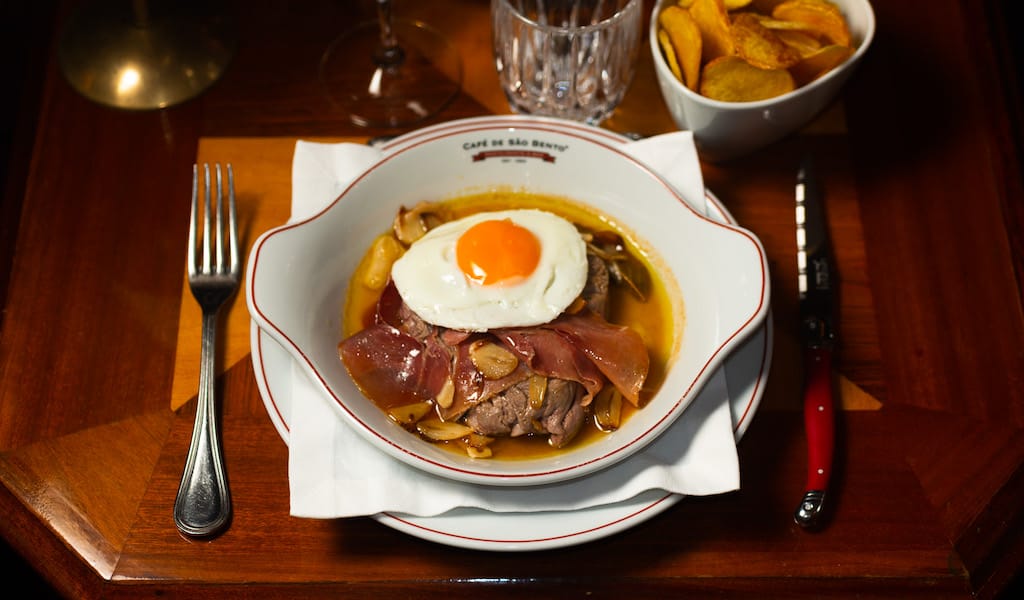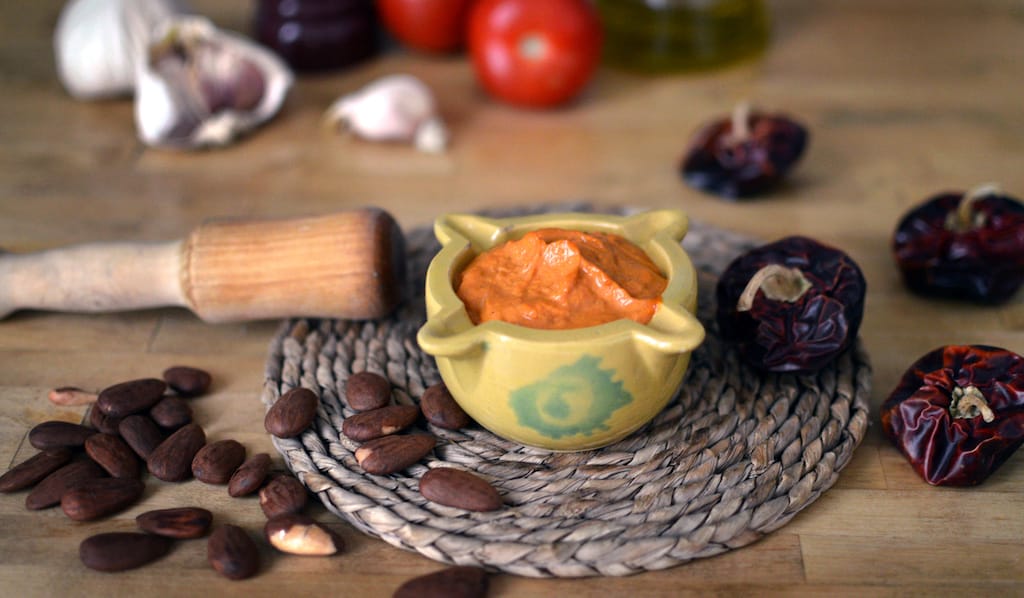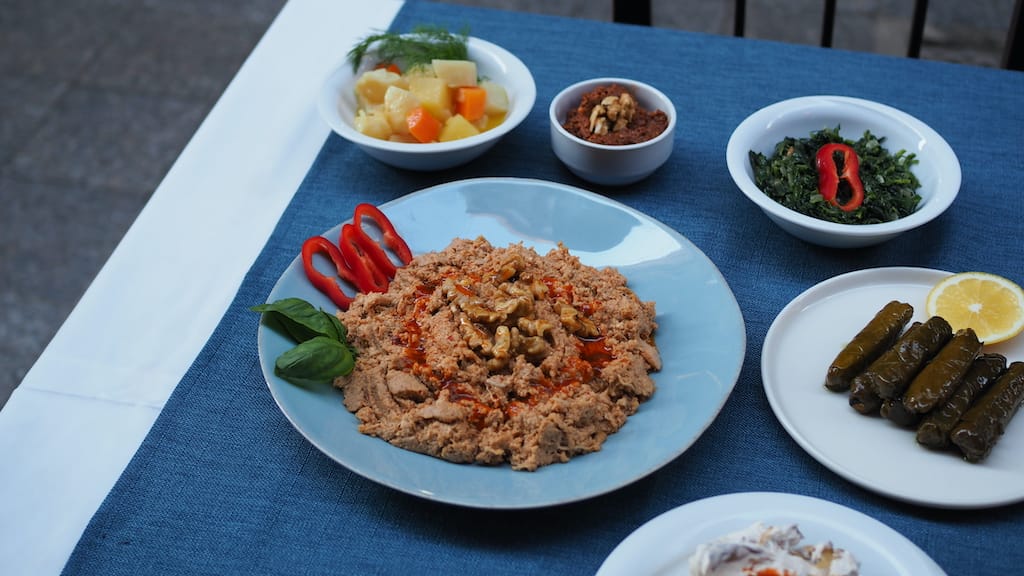In most countries around the world, it’s safe to say that steak is a minimalist affair – a dish that, in some cases, combines perhaps no more than beef and salt. In Portugal, however, people tend to go in the other direction.
“It’s a steak that’s pan-fried, and served with smoked ham, bay leaf, garlic and white wine,” says Manuel Fernandes, when we ask him to describe the country’s signature steak dish, bife à portuguesa, “Portuguese-style steak.”
 And he should know; since 1987, Chef Manuel has been making the dish at Café de São Bento, probably Lisbon’s most famous venue for steak.
And he should know; since 1987, Chef Manuel has been making the dish at Café de São Bento, probably Lisbon’s most famous venue for steak.
Opened in 1982 as an homage to the steakhouses that had a massive influence on Lisbon’s dining scene during the first half of the 20th century, Café de São Bento retains this legacy via heavy furniture, lots of wood and velvet and framed portraits. A location across the street from Palacete de São Bento, the seat of Portugal’s parliament, means that VIP diners wearing suits and neckties are the norm.

Bife à portuguesa definitely does not clash with these upscale elements. But despite the dish’s traditional-sounding name, it’s likely a relatively recent addition to the Portuguese repertoire. In Tratado do Petisco, Virgílio Nogueiro Gomes writes that beef dishes were rare in early Portuguese cookbooks, and most early recipes call for grilling beef over coals. Pan-fried steaks only started to appear in Portuguese cookbooks in the 20th century, and were probably mostly associated with Lisbon.
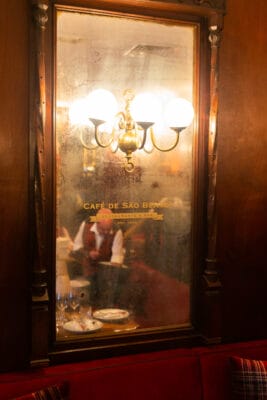
Although some of bife à portuguesa’s elements – smoked ham, white wine – may sound decadent to us, they’re fairly standard in Portugal. Yet what’s more remarkable is how these disparate elements come together, particularly in the sauce, an on-the-fly reduction of white wine.
“It should be well-seasoned but not too salty. It should have an aroma from the garlic and bay leaf,” says Chef Manuel, of the sauce, whose hack is adding butter at the end, a move that both emulsifies the sauce and makes it richer.
In the midst of all these elements, the beef can almost seem like an afterthought. In terms of cuts, the steaks at Café de São Bento are made exclusively with tender, lean lombo (filet mignon) or vazia (sirloin) – Chef Manuel prefers the latter, as it “has more flavor.”
If bife à portuguesa has one truly over-the-top element, we’d argue that it’s the fact that the dish is crowned with a fried egg.
“A fried egg is obligatory!” Chef Manuel tells us of what must be one of the world’s more decadent garnishes, which in Portugal is known as a cavalo, “cowboy-style.”
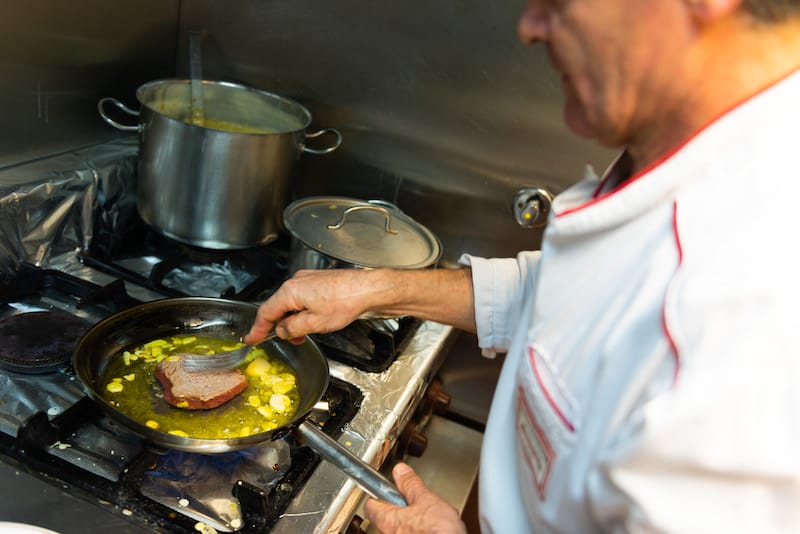
Recipe: Bife à Portuguesa, Portuguese-style steak
This is, more or less, how Chef Manuel Fernandes makes Portuguese-style steak at Café de São Bento. We’ve shifted the addition of bay leaf and garlic to a later step, for more control for the home cook, but the results are the same.
If you want an especially lean, tender cut, opt for a lombo, equivalent to sirloin. We prefer a bit more fat and texture, and opted for vazia, beef tenderloin. A cheaper cut, such as pojadouro (roughly equivalent to rump or topside steak) works fine for this treatment as well, and is what you’ll find most places in Lisbon.
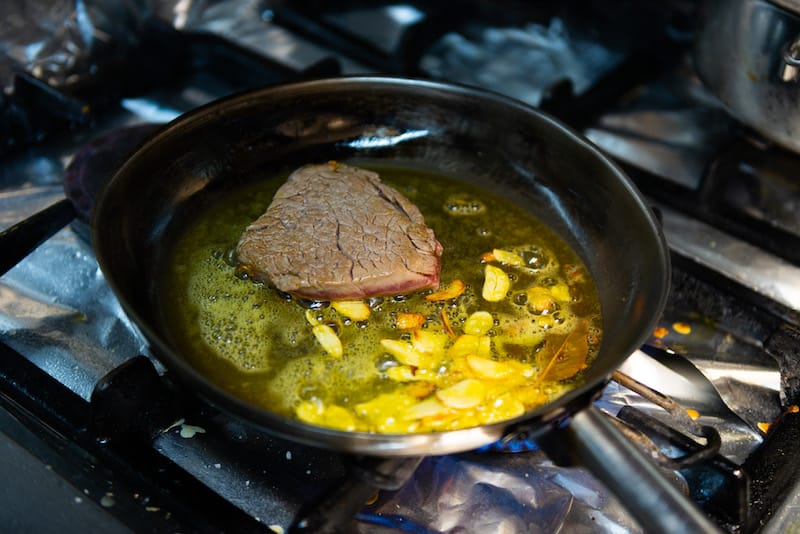
Cooking a steak happens quickly, and you don’t want to have to be searching for ingredients or turn off your flame mid-process, so an important step here is setting up your mise en place – chef talk for the ingredients you’ll need easily at hand. Make sure that your olive oil, butter, beef, garlic, bay leaf, white wine, cured ham and egg (if using) are all ready to go.
And the fried egg is, of course, optional (but not really).
At Café de São Bento, this dish would be accompanied by potatoes, sliced thinly and deep-fried in house. To avoid the mess and fuss of frying potatoes at home, a hack we suggest is to simply buy high-quality, relatively thick “kettle”-style chips (in Portugal, we opt for Ti-ti brand).
This recipe makes one relatively large steak; simply up the amounts and repeat the steps for additional diners.

Serves 1
½ teaspoon coarse salt
2 tablespoons extra virgin olive oil
4 teaspoons butter
200-250g lombo (sirloin) or vazia (filet mignon) steak, ideally around 3cm thick
3 cloves garlic (15g total), peeled and sliced
1 bay leaf
½ cup white wine
1 thin slice of presunto (Portuguese smoked ham)
1 egg (optional)
Chips
Sprinkle the coarse salt over both sides of the steak. Set aside.
In a medium sized-saucepan over high heat, add the olive oil and 1 teaspoon of the butter. When the butter melts, add the steak, flipping occasionally and pressing to sear, frying until it has reached your desired degree of doneness. Remove the steak to a serving plate.
Reduce the heat to medium, add the garlic and bay leaf and sauté, stirring occasionally, until fragrant and just starting to brown, around 1 minute. Add the white wine, increase the heat to medium-high and bring to a rapid simmer. Add the smoked ham and “poach” in the wine until just firm, about 10 seconds. Remove the ham and place it on top of the steak. Add 2 teaspoons of butter to the wine mixture, stirring to combine and melt, and maintain at a rapid simmer until the liquid is reduced by a half or so and is just starting to get sauce-like and just barely thick syrupy. Pour this sauce over the steak.
Wipe the pan clean, add the remaining 1 teaspoon of butter, and fry the egg, sunny-side-up, being careful not to break the yolk. Top the steak with the fried egg.
Serve the steak with chips.
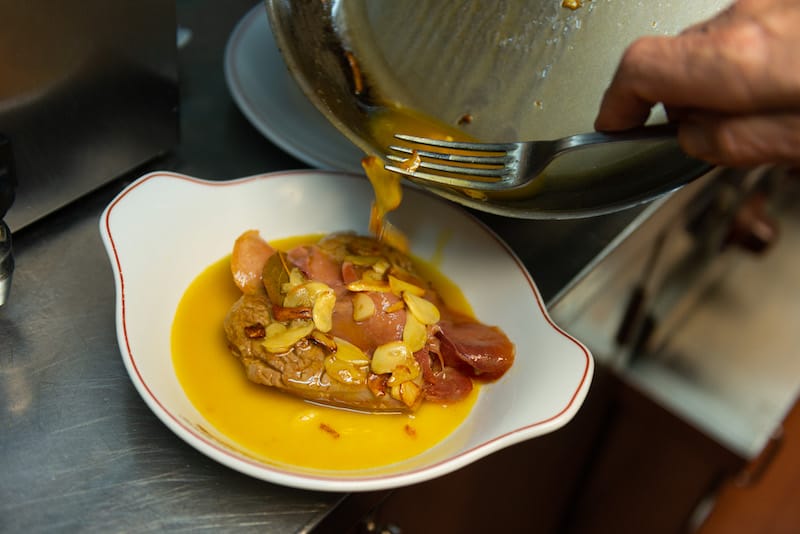
 April 2, 2024 Grandma’s Folar Recipe
April 2, 2024 Grandma’s Folar Recipe
Folar is the generic name given to traditional Easter sweet bread in Portugal. Making it […] Posted in Lisbon March 20, 2024 Recipe
March 20, 2024 Recipe
Served as a sauce, romesco is certainly striking: It has an intense dark orange color […] Posted in Barcelona February 16, 2024 Recipe
February 16, 2024 Recipe
Some recipes are so deeply connected with the region from which they originate that they […] Posted in Istanbul
Austin BushAustin Bush
Published on March 31, 2023
Related stories
April 2, 2024
LisbonFolar is the generic name given to traditional Easter sweet bread in Portugal. Making it from scratch is somewhat of a long process, but being confined due to the coronavirus crisis, we seem to have a bit more time on our hands than expected. My family’s folar recipe is from my grandmother Felismina, who was…
March 20, 2024
BarcelonaServed as a sauce, romesco is certainly striking: It has an intense dark orange color and a dense texture that saturates and blankets whatever you dip in it. Once in the mouth, you get a piquant touch of vinegar, which is soon enveloped by the nutty creaminess of ground almonds (or perhaps hazelnuts) and olive…
February 16, 2024
Istanbul | By Lian Penso Benbasat
IstanbulSome recipes are so deeply connected with the region from which they originate that they are simply named after that place. Circassian chicken, an appetizer beloved in Turkey and throughout the Caucasus, is such a dish. The recipe itself takes on many different variations across different geographical locations, much like the mosaic of people and…







































